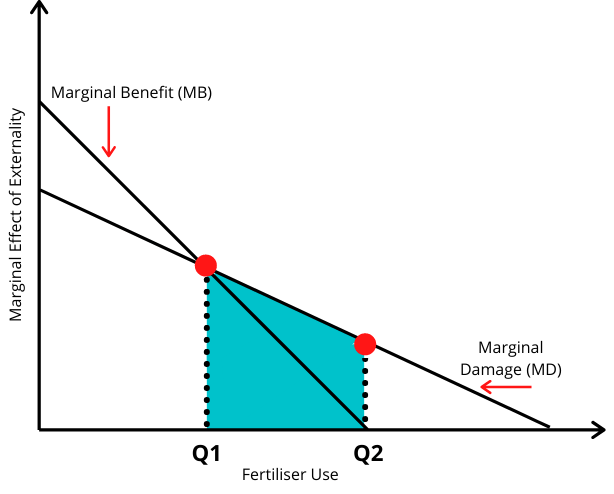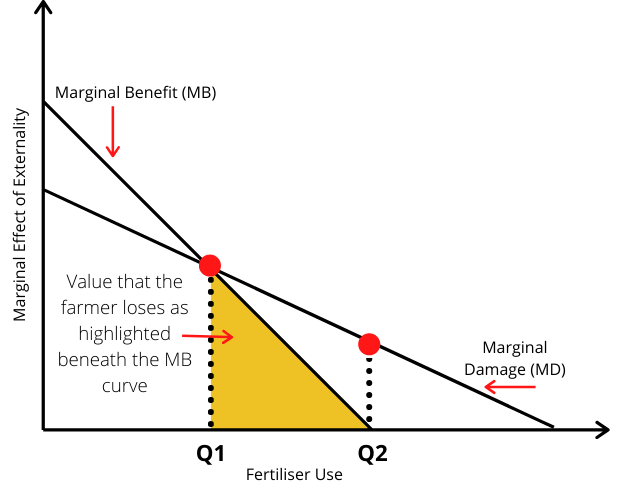Coase Theorem: Definition & Example

What is the Coase Theorem?
Coase theorem is the idea that under certain conditions, issuing property rights can solve negative externalities. For example, a Forrester will manage their forest to ensure its longevity and protect it from fires. There is an incentive to do so in order to be able to sell logs in future years.
The Coase theorem was originally coined by economist, Ronald Coase, in his 1960 paper, ‘The Problem with Social Cost’. He explains that property rights can become conflicting, thereby resulting in inefficient economic results. When property rights are not clearly defined, disputes can arise.
Key Points
- Coase theorem is the idea that under certain conditions, the issuing of property rights can solve negative externalities.
- Coase theorem is only applicable when transaction controls are zero.
- There are a number of assumptions to Coase theorem, many of which are not applicable in the real world.
In the case of the Coase theorem, consider a scenario where a business pollutes a river, leading to negative externalities for individuals who enjoy walking past the river. With undefined property rights to the river, lawsuits and costly legal battles may ensue.
The Coase theorem suggests that in such cases, it is more efficient to have clearly defined property rights and allow both parties to engage in bargaining. However, this assumption relies on the absence of transaction costs. It is important to note that legal costs and other transaction expenses may be involved in the process.
Under an agreement based on the Coase theorem, the business would own the right to pollute the river, while the individual would compensate the business for access to and use of the river. This arrangement creates an incentive for the business to reduce pollution in order to generate income from the individual.
Coase Theorem Example
The Coase theorem emphasizes the importance of assigning property rights to address negative externalities and achieve a more efficient allocation of resources. Without clearly defined property rights, such as in the case of noise or air pollution, there can be an inefficient distribution of costs and benefits.
According to the Coase theorem, negative externalities can be resolved by assigning property rights and allowing the affected parties to negotiate. To illustrate this, let’s consider an example involving a farmer and downstream fishers. The farmer’s use of fertilizer leads to pollution in the nearby river, negatively impacting the fishers’ ability to catch fish and potentially affecting others downstream.
In the absence of property rights, it becomes challenging to account for the costs imposed on the fishers. Without a mechanism to attribute these costs, a lengthy and costly legal battle may ensue. The Coase theorem proposes assigning property rights and enabling negotiations between the parties involved. This allows for the true economic cost of the pollution to be determined and addressed in a more efficient manner.

In the scenario where the farmer has clearly defined, divisible, and defendable property rights, they would have the right to use pesticides on their crops. However, this activity generates a negative externality that imposes costs on the fishers downstream. To resolve this, both parties would engage in negotiations to determine the value of reducing or mitigating the negative externality.
The fisher would pay the farmer an amount based on the value they attribute to being able to fish in the river. This amount could range from $50 to $1,000, depending on the perceived value. The crucial aspect is that the price is determined by the value the farmer has to forgo by reducing the use of pesticides, which may result in lower crop yields.
Conversely, if the fisher owns the river, the farmer would have to compensate the fisher for any negative externality caused by the fertilizer runoff. The compensation would be based on the extent to which the fertilizer affects the river.
The underlying principle of the Coase theorem is that the value of the negative externality is recognized and accounted for. By engaging in negotiations and assigning property rights, the external costs are internalized and mutually agreed upon compensation is established.
Coase Theorem Illustrated
To help us understand Coase theorem further, let’s illustrate it below.
As we can see from the chart, we have a negative externality, the fertiliser use on the x-axis. On the y-axis, we have the marginal effect of the externality on both parties. The reason both lines are downwards sloping is that there comes a point where adding extra fertiliser into the river cannot do any more damage than it already has. At the same time, the marginal benefit slope goes to Q2 which refers to the point where there is no additional benefit to the farmer of using more fertiliser.

When there are property rights, the optimal point on the chart would be at Q1 where the marginal benefit is equal to the marginal damage. That way the farmer can produce up to the point by which the fisher is willing to accept and pay to use the river.
When property rights do not exist, the farmer will produce up to point Q2, until there is no further benefit in using more fertilizer. That way, the fisher loses all the welfare between Q1 and Q2. In other words, the damage that is caused between the equilibrium and the actual point that the farmer produces to.

Let us now allocate property rights to the farmer. Under the Coase theorem, this would also mean that there are no transaction costs, property rights are well defined, and are enforceable.
When property rights are allocated, bargaining can occur. In this instance, the fisher can now bargain with the farmer as to how much fertilizer to use. The fisher would prefer the farmer to change production from Q2 (maximum negative externality) to Q1 (socially optimal for both parties). In turn, this will mean that the fisher now gains the amount of welfare shaded in blue.
At the same time, the farmer loses out from shifting his production from Q2 to Q1. Less fertilizer is used, so crop yields can also become affected.

What we can tell from the two charts above, is that the value to the fisher below the marginal damage line and between Q1 and Q2; is greater than the value to the farmer as per the chart above.
In other words, the fisher gains more from the transition than the farmer. In turn, the fisher is willing to pay the farmer more than he loses. Yet less than he is gaining. Therefore, both parties will be better off and we reach the socially optimal level of production.
What we see as a result is a Pareto improvement. This is where both parties are better off and all externalities are internalized. So the market is working efficiently because of property rights.
Coase Theorem Assumptions
The Coase theorem only works under certain assumptions. They are:
1. No Transaction Costs
When we say there are no transaction costs, this refers to the cost of identifying affected parties or trading partners. For instance, the farmer would have to find fishers downstream in order to bargain with them.
Then, there is the case of the agreement. That may require legal fees that add to the transaction cost. We also have compliance. The fisher may want to monitor how much fertilize the farmer is using to ensure he stays within the agreement; another transaction cost. So for coase theorem to exist, there cannot be any of these transaction costs otherwise economic efficiency is not achieved.
2. Perfect Information
Without perfect information, the socially optimal point will not be reached between two parties. We may move closer towards it, but not reach it. This is because, without perfect information, both parties will be unable to determine value. If we look back on the farmer example, if the farmer does not know how much of an impact halving his fertilizer use would have, he is unable to value it effectively.
The farmer may always use the same amount of fertilizer, so has little idea on what his crop yield will be like without it. In turn, the value they place is likely to be wide of the mark as there is no indicative data. The result is therefore economically inefficient as the value of pollution is likely to vary dramatically from the true value. So Coase Theorem assumes that the farmer and all other parties have information on the value of such externalities and the cost to them individually.
3. Equal Market Power
When we talk about a fisher and a farmer, we may consider them equals. The Coase theorem assumes that both parties have equal power. However, Walmart is going to have greater negotiating power with a small farmer because it has the ability to buy their entire stock.
In turn, the socially optimal point cannot be reached as the negotiations are skewed in favor of the stronger party. This means that the weaker side has the value of the externality undervalued – essentially meaning they are at a net loss when compared to the comparative gain of the other party. So for Coase Theorem and the power of property rights to work, it is assumed that both parties have equal market power.
Limitations of Coase Theorem
1. Bargaining is difficult
The Coase theorem relies on efficient and effective bargaining between two parties to reach the socially optimal level of production. However, that is easy to show on a graph, but how do two individuals know or even care to reach that level?
At the same time, you may have two parties that are very different. This may be a difference in size and power, which gives them greater negotiating power. Or, the other individual may have more experience in negotiating and is, therefore, able to bargain for a better deal than would otherwise occur. In the real world, there is likely to be an uneven balance in bargaining power which leads to a sub-optimal result. Whilst Coase Theorem states property rights can improve economic outcomes, the assumption that bargaining power is equal does not hold up in the real-world.
2. Transaction costs are almost never zero
Although one party may own the property right, there are almost always associated transaction costs. For instance, once a bargain is reached, particularly to reduce pollution, it will most likely need policing. That would require some form of inspections or tests to ensure the threshold or agreed quota is not exceeded.
We also have potential legal fees that would be needed to reach a formal and legally binding agreement. There may also be cases where payment is not made which would then require further legal costs in order to collect such dues. For instance, several monthly payments are missed and therefore legal action may be needed.
3. Distribution of Income is Affected
Whoever owns the property rights will be the party that ends up receiving the income from the other. So if the farmer owns the rights to the river, the fisher must pay him to use it. At the same time, if the fisher owns the river then it will be the farmer that has to pay.
The issue occurs when we decide who owns the property. Will it be issued to the highest bidder? If so, income discrepancies may only be extended. Those who have the highest amount of wealth are able to dictate the cost of externalities.
4. Unlikely assumptions
There are a number of assumptions of Coase Theorem which includes the absence of transaction costs, equal bargaining power, and perfect information. Yet in the real-world, the assumptions are improbable. There is always one assumption which does not seem to apply.
FAQs
The Coase theorem is the idea that under certain circumstances, property rights are able to resolve negative externalities.
The Coase theorem dictates that it only works when transaction costs do not exist. However, in reality, there are always some form of transaction costs. This may be ensuring the agreement is adhered to and monitored, and/or the legal expenses required to draft a legal agreement. Under such circumstances, an equilibrium point is unable to be reached and may cause more costs than the original negative externality imposed.
Coase theorem seeks to solve negative externalities by assigning well defined property rights. In turn, two parties can negotiate based on the cost of that externality and the price they are willing to accept in order to reduce such.
About Paul
Paul Boyce is an economics editor with over 10 years experience in the industry. Currently working as a consultant within the financial services sector, Paul is the CEO and chief editor of BoyceWire. He has written publications for FEE, the Mises Institute, and many others.

Further Reading
 Human Development Index - The Human Development Index (HDI) is a composite measure that assesses a country's overall development based on indicators such as…
Human Development Index - The Human Development Index (HDI) is a composite measure that assesses a country's overall development based on indicators such as…  Covariance - Covariance is a statistical measure that quantifies the relationship and degree of variation between two variables.
Covariance - Covariance is a statistical measure that quantifies the relationship and degree of variation between two variables.  Bounded Rationality: Definition & Examples - Bounded rationality highlights the limitations of humans’ ability to make optimal decisions.
Bounded Rationality: Definition & Examples - Bounded rationality highlights the limitations of humans’ ability to make optimal decisions. 
